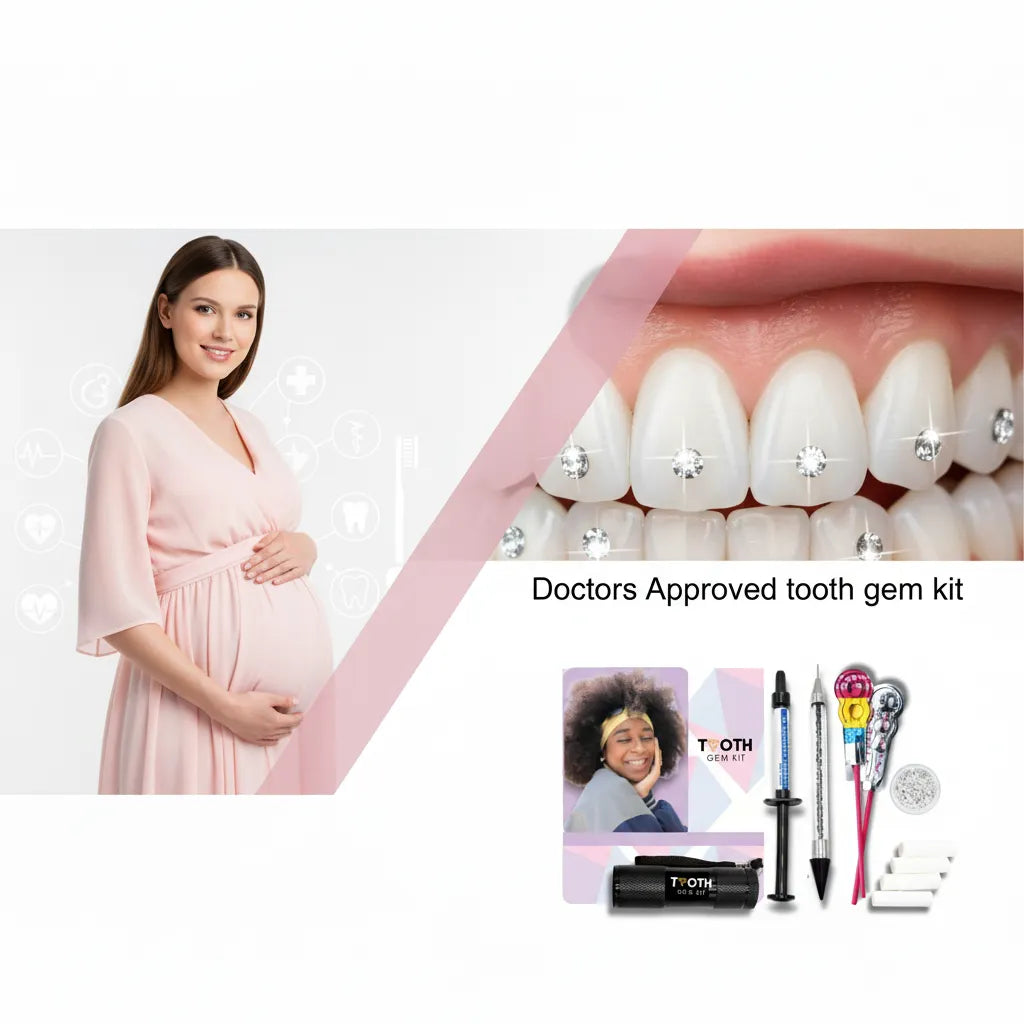
Are Tooth Gems Safe During Pregnancy? Expert Advice for Expectant Mothers
Share
Last Updated: September 2025 | Medically Reviewed Content
Pregnancy brings numerous questions about what is safe for both mother and baby, and dental aesthetics are no exception. If you are expecting and considering tooth gems, you are likely wondering about their safety during this crucial time. This comprehensive guide provides expert-backed insights to help you make an informed decision.
What Are Tooth Gems? Understanding the Trend
Tooth gems are small decorative crystals, typically made from Swarovski crystals, cubic zirconia, or genuine diamonds that are professionally bonded to teeth using dental adhesive. This cosmetic dental procedure has gained significant popularity on social media platforms, offering a way to add sparkle to your smile without permanent modification.
Types of Tooth Gems Available:
- Swarovski Crystal Gems: Most popular option, available in various colors
- Cubic Zirconia: Diamond-like appearance at lower cost
- Genuine Diamonds: Premium option for maximum brilliance
- Gold Designs: Metallic alternatives for unique aesthetics
Read Now: Tooth Gems for Teens: What Parents Need to Know
Pregnancy and Dental Health: What Changes Occur?
During pregnancy, your body undergoes significant hormonal changes that directly affect oral health. Understanding these changes is crucial when considering any dental cosmetic procedure.
Hormonal Effects on Oral Health:
- Increased Blood Flow: Gums become more sensitive and prone to bleeding
- Pregnancy Gingivitis: Affects 60-75% of pregnant women
- Enhanced Bacterial Growth: Hormones can promote harmful bacteria
- Enamel Softening: Acid reflux and morning sickness can weaken teeth
- Immune System Changes: Reduced ability to fight oral infections
Are Tooth Gems Safe During Pregnancy? The Expert Verdict
The consensus among dental professionals is cautious optimism with important caveats. While tooth gems themselves are not inherently dangerous during pregnancy, several factors make the timing less than ideal.
Why Dental Experts Express Concerns:
1. Infection Risk Amplification Pregnancy naturally suppresses immune function to prevent rejection of the developing baby. This immunocompromised state means that any bacterial introduction around the tooth gems could lead to more severe infections that might affect both the mother and the child.
2. Gum Sensitivity Issues Pregnancy gingivitis makes gums swollen, tender, and more likely to bleed. The bonding process and ongoing presence of tooth gems can exacerbate these symptoms, leading to chronic discomfort.
3. Limited Treatment Options If complications arise, treatment options become restricted during pregnancy. Many antibiotics and dental procedures carry risks, leaving fewer safe intervention choices.
4. Oral Hygiene Challenges Morning sickness, fatigue, and increased gag reflex during pregnancy can make thorough oral hygiene more difficult. Tooth gems require meticulous cleaning to prevent bacterial buildup.
Read Also: Oral Hygiene with Tooth Gems: A Complete Care Guide
First Trimester Considerations: Critical Development Period
The first trimester (weeks 1-12) is particularly crucial for fetal organ development. During this time, dental professionals strongly advise against non-essential cosmetic procedures.
Key First Trimester Concerns:
- Organ formation sensitivity to infections
- Higher risk of miscarriage from systemic infections
- Morning sickness complicating aftercare
- Increased chemical sensitivity
Second and Third Trimester: Timing Matters
Second Trimester (Weeks 13-26): Generally considered the safest time for necessary dental work, but tooth gems remain non-essential.
Third Trimester (Weeks 27-40): Physical discomfort from positioning during procedures and proximity to delivery make this timing inadvisable.
Potential Risks of Tooth Gems During Pregnancy
Immediate Risks:
- Allergic Reactions: Heightened sensitivity during pregnancy
- Tooth Damage: The Bonding process stresses already vulnerable enamel
- Gum Irritation: Exacerbation of existing pregnancy gingivitis
- Infection at Application Site: Entry point for harmful bacteria
Long-term Concerns:
- Enamel Erosion: Removal process damage to pregnancy-weakened teeth
- Chronic Inflammation: Prolonged gum irritation affecting oral health
- Bacterial Colonization: Persistent infection sources
- Tooth Sensitivity: Increased sensitivity that may persist postpartum
Get the guide now: When NOT to Use Tooth Gems: Medical Considerations
Professional Recommendations: What Dentists Advise
Leading dental organizations and pregnancy specialists generally recommend postponing cosmetic dental procedures until after delivery and breastfeeding completion.
Alternative Options Suggested by Experts:
- Temporary Lip Gems: Applied to lips instead of teeth
- Dental Whitening Alternatives: Safe pregnancy-approved brightening methods
- Orthodontic Consultation: Planning post-pregnancy dental improvements
- Enhanced Oral Hygiene: Focus on optimal dental health during pregnancy
Safe Timing: When to Consider Tooth Gems
Ideal Timeline for Tooth Gem Application:
- Pre-Conception: Best time for planning pregnancy
- Post-Delivery: Wait a minimum of 6-8 weeks after birth
- After Breastfeeding: If choosing to breastfeed, wait until weaning
- Hormonal Stabilization: Allow 3-6 months for hormone normalization
Maintaining Oral Health During Pregnancy Instead
Rather than focusing on cosmetic additions, pregnancy is an ideal time to optimize overall oral health for both mother and baby.
Essential Pregnancy Oral Care:
- Regular Dental Checkups: Every 3-4 months during pregnancy
- Gentle Brushing: Soft-bristled toothbrush twice daily
- Fluoride Toothpaste: Safe and beneficial during pregnancy
- Antimicrobial Mouthwash: Alcohol-free options recommended
- Nutritional Support: Calcium and vitamin D for dental health
Addressing Common Myths and Misconceptions
Myth 1: "Tooth gems are completely harmless."
Reality: While generally safe for non-pregnant individuals, pregnancy creates unique risk factors that must be considered.
Buy our dentist-approved tooth gem kit now
Myth 2: "The adhesive is always safe"
Reality: Some dental adhesives contain chemicals that may be concerning during pregnancy's sensitive periods.
Myth 3: "You can't get infections from tooth gems."
Reality: Any foreign object in the mouth can harbor bacteria, and pregnancy reduces the immune response to fight infections.
Expert Interviews and Professional Opinions
Dr. Sarah Martinez, DDS, specializing in prenatal dental care, states: "While I understand the desire to maintain aesthetic appearance during pregnancy, the risks associated with non-essential dental procedures generally outweigh the benefits. I recommend waiting until after pregnancy and breastfeeding completion."
The American Dental Association emphasizes that elective cosmetic procedures should be postponed during pregnancy, focusing instead on preventive care and treatment of urgent dental issues.
Post-Pregnancy Considerations: Planning for the Future
If you are committed to getting tooth gems, use pregnancy as a planning period to research qualified practitioners and prepare for the post-delivery application.
Preparation Steps:
- Research a certified professional tooth gem kit
- Understand aftercare requirements
- Plan timing around breastfeeding decisions
- Consider long-term maintenance needs
- Budget for quality materials and professional application
Making an Informed Decision: Key Questions to Ask
Before making your final decision, consider these essential questions:
- Is this the right timing? Consider your pregnancy stage and overall health
- What are my alternatives? Explore temporary or safer options
- Who will perform the procedure? Ensure proper certification and experience
- What's my risk tolerance? Weigh potential complications against the desired outcome
- Can I wait? Consider if postponing is the most prudent choice
Conclusion: Prioritizing Health Over Aesthetics
While tooth gems can be a beautiful addition to your smile, pregnancy is a time when health considerations should take priority over cosmetic desires. The combination of increased infection risk, limited treatment options, and hormonal changes affecting oral health makes this timing less than ideal.
The safest recommendation is to wait until after pregnancy and breastfeeding completion before considering tooth gem application. This approach ensures the best possible outcome for both you and your baby while still allowing you to achieve your desired aesthetic goals at a more appropriate time.
Remember, pregnancy is temporary, but the decisions you make during this time can have lasting effects. Focus on maintaining excellent oral health throughout your pregnancy, and save cosmetic enhancements for when your body has returned to its non-pregnant state.
“This article is for informational purposes only and should not replace professional medical or dental advice. Always consult with qualified healthcare providers before making decisions about dental procedures during pregnancy.”
